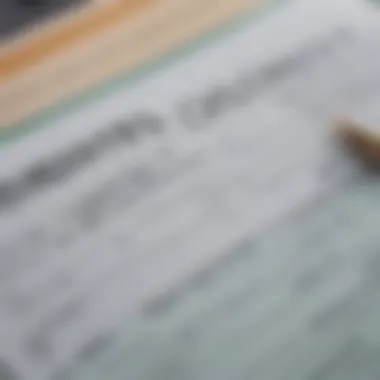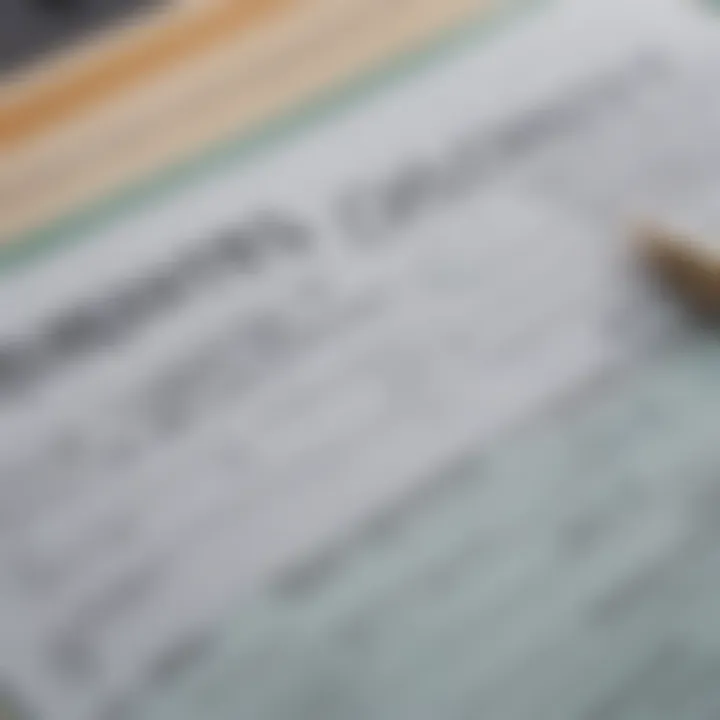Understanding Two-Party Personal Checks and Their Uses


Intro
Two-party personal checks serve as a unique financial instrument, allowing two individuals to share responsibility in a single transaction. For many, this might seem like a minuscule detail, yet it carries significant implications for personal finance and business dealings. Whether you're paying a friend back for concert tickets or splitting the cost of a fancy dinner, understanding how these checks function can streamline interactions and ensure both parties feel secure.
In this guide, we'll wade through the essential concepts surrounding two-party checks. From their definitions and everyday applications to the legal considerations involved, this article aims to shine a light on both the benefits and potential pitfalls that these checks may present. By the end, you’ll emerge with a solid grasp of what it means to navigate the world of two-party checks, enhancing your overall financial literacy in the process.
Investment Terminology Breakdown
Understanding the terms related to two-party personal checks is pivotal for anyone looking to utilize this payment method properly. Let’s break down some of the key concepts one might encounter.
Key Terms Explained
- Two-party check: A check that is payable to two people, usually requiring both parties' endorsement for cashing or depositing.
- Endorsement: The act of signing the back of the check to authorize its transfer or payment. Both parties typically need to add their signatures for the transaction to proceed.
- Clearing process: The banking system’s procedure for checking and validating the authenticity of a check before releasing funds to the payee's account. This could take a couple of business days.
Common Misconceptions in Investing
Many believe that two-party checks are simply less formal or risky than traditional checks. However, it’s vital to approach them with diligence. Common misconceptions include:
- Perceived Safety: While a two-party check may feel like a safer option among friends, it can still bounce if funds aren't available, leading to potential trust issues.
- Legal Protection: Some individuals think that two-party checks offer legal protection similar to contracts. While they can outline agreements, they do not guarantee enforceability without proper documentation.
"Understanding the nuances of financial instruments helps individuals engage more effectively in their transactions, fostering better relationships in both personal and professional landscapes."
In the sections that follow, we will delve into the specific applications of two-party checks, the legal intricacies, and their advantages and disadvantages to provide a comprehensive understanding of this important financial tool. Stay tuned.
Preamble to Two-Party Personal Checks
Two-party personal checks serve as a unique financial instrument, bridging the gap between traditional single-party checks and the rigidities of other payment methods. In an age where financial transactions are rapidly digitizing, grasping the nuances of these checks becomes even more pertinent.
Importance of the Topic
In financial advisement and investment strategies, knowledge about two-party personal checks is invaluable for several reasons:
- Enhanced Flexibility: Unlike standard checks which can only be written to one individual or entity, two-party checks allow for joint interactions, making them ideal in many personal and business contexts.
- Risk Mitigation: By involving both parties prominently, there's often less scope for disputes. Each party is clearly designated, helping to clarify expectations and reduce misunderstandings.
- Trust Building: These checks can reassure parties about the integrity of the transaction, especially in situations involving large sums or complex dealings.
To illustrate just how beneficial two-party checks can be, consider a scenario where a parent needs to fund their child's college tuition. Instead of writing a solitary check to the institution, two-party checks can inject additional control by having the child involved directly in the financial transaction. This encourages accountability and can bolster financial literacy for younger individuals.
"In every financial transaction, clarity equals peace of mind. Two-party checks pave the way for that clarity."
Defining Two-Party Personal Checks
When discussing financial transactions, it's vital to grasp the nuances of various payment methods. Two-party personal checks hold a definitive place in this landscape. Understanding what they are and how they function can empower individuals and businesses alike, enabling more informed decisions in their financial dealings.
Understanding the Basics
To get a clearer picture, let’s dissect the essence of two-party personal checks. Unlike standard checks that involve only the payer and the recipient, two-party checks involve an added layer of complexity by introducing a third party's name, ensuring that the funds are directed towards a specific purpose. Typically, this means that both parties must endorse the check for it to be cashed or deposited.
Imagine a scenario where a parent writes a two-party check to their child for purchasing a specific item, like a laptop. In this case, the parent writes the check out to the store with the child’s name also endorsed on it, limiting the use of the funds strictly to that transaction.
Key Characteristics
Some defining traits elevate two-party checks above their single-party counterparts:
- Endorsement Requirement: Both parties must endorse the check for it to be usable.
- Limited Use: The check is geared towards a specific vendor or purpose, reducing misuse.
- Negotiable Instrument: Just like other checks, two-party checks can be treated as negotiable instruments, meaning they can be transferred to others.
"A two-party check serves as a bridge of trust between individuals and vendors, enhancing the integrity of personal transactions."
Furthermore, these checks provide more security than traditional checks, as they can help mitigate risks of theft or fraud. If a two-party check ends up in the wrong hands, it still requires the right endorsements, which adds an extra layer of protection against unauthorized use.
Navigating through the intricacies of two-party personal checks is more than just about writing names; it’s about ensuring transparency and security in financial transactions. Understanding these crucial elements sets the stage for knowing when and how to effectively use them.
The Mechanism of a Two-Party Personal Check
The mechanism surrounding two-party personal checks is essential to understanding their functionality in financial transactions. These checks serve as a bridge between two parties, typically a payer and a payee, facilitating payments in various situations. The way these checks operate provides unique benefits, such as enhanced security and clarity in transactions, which makes them a favored choice for many. Moreover, understanding how they work contributes significantly to one’s financial literacy.
How Two-Party Checks Work
At the core of a two-party personal check is its outright designation for two individuals or entities. Essentially, one person writes the check, while both must endorse the payment. Here are the crux of its operation:


- The Drawer: This is the person who issues the check. When they write a two-party check, they have to specify both the amount and the name of the second party.
- The Payee: The second party, who is also mentioned on the check, stands to receive the payment. Both parties must endorse it to finalize the transaction.
- Bank Involvement: The check is then taken to a financial institution for processing, where funds are debited from the drawer’s account and credited to the payee’s account.
This process not only adds a layer of accountability but also ensures both parties have a say in the transaction. It’s like having both feet firmly planted in a boat; neither party can tip the boat without the other's agreement.
The Process of Writing a Two-Party Check
Writing a two-party personal check follows a straightforward procedure, but requires precision. Here’s a step-by-step outline:
- Gather Necessary Details: Before writing the check, the drawer needs to collect the recipient details, including their full name and the amount of money.
- Fill in the Check: On the face of the check, the drawer will write the name of the first party (the one writing the check), the name of the second party (the recipient), the amount in both numerals and words, and a date if required.
- Sign the Check: It's imperative that the drawer signs the check to authenticate it, making it a legally binding document.
- Endorsement by the Payee: The payee must also endorse the check, signaling their acceptance of the payment.
"Properly filling out a two-party check is like laying the groundwork for a solid structure; every detail counts."
By adhering to this process, the involved parties can avoid potential pitfalls and ensure that the transaction proceeds smoothly.
In summary, the mechanism of two-party checks is both nuanced and practical, paving the way for secure transactions across personal and professional landscapes.
Eligibility and Requirements
Understanding the eligibility and requirements surrounding two-party personal checks is essential for anyone looking to navigate this financial instrument effectively. These checks offer unique benefits but come with specific criteria for issuance and acceptance that can significantly impact their usability in various transactions. Knowing who can issue them and the conditions for acceptance helps individuals and businesses ensure they are leveraging this payment method effectively.
Who Can Issue a Two-Party Check
A two-party check typically involves at least two parties: the payer (the individual writing the check) and the payee (the individual or entity receiving the payment). Notably, here are some key points regarding who can issue such checks:
- Individuals: Any adult who has a checking account can write a two-party check. This includes individuals in a personal capacity who wish to pay someone else directly.
- Businesses: A business entity having a checking account can also issue two-party checks. This is common, especially in transactions involving suppliers or partners.
- Trustees and Executors: In cases involving estates or trusts, authorized individuals can issue these checks on behalf of the estate or trust.
In a nutshell, almost anyone with a checking account can issue a two-party check, as long as they adhere to the necessary procedures during the transaction.
Conditions for Acceptance
While issuing a two-party check may look straightforward, acceptance hinges on certain conditions that both the payer and payee should consider. Here are some of the most pertinent conditions:
- Verification of Identity: Both parties must verify their identities, especially in larger transactions. The payee should confirm the payer’s identity to avoid any confusion or fraud.
- Bank Policies: Not all banks have the same policies regarding the acceptance of two-party checks. Some banks may require additional documentation to ensure the legitimacy of the transaction.
- Endorsement: For a two-party check to be accepted, it must be endorsed by the payee. This means the payee needs to sign the back of the check before cashing it or depositing it into the bank.
- Date and Amount: The check must be correctly filled out with the date, amount, and names of both parties. Any errors may lead to refusal at the bank.
"A well-prepared check leaves less room for disputes and makes transactions smoother for everyone involved."
Advantages of Two-Party Personal Checks
Two-party personal checks come with a range of advantages that can significantly benefit both the issuer and the payee. Understanding these advantages is crucial for anyone looking to utilize this form of payment effectively, whether in personal situations or business dealings. The unique attributes of two-party checks offer peace of mind and facilitate smoother transactions.
Security Benefits
One of the standout features of two-party personal checks is their enhanced security. Unlike typical one-party checks, these instruments require the endorsement from both the sender and the recipient. This additional requirement adds a layer of protection, making it increasingly difficult for unauthorized individuals to cash the check. When both parties are involved, there's less likelihood of accidental payments complicated by unclear authorizations.
For example, imagine John writes a two-party check to Sarah, both having to sign to cash it. Let’s say the check goes missing; the potential thief can’t just run off to cash it without Sarah's signature. This dual endorsement essentially acts as a safety net, safeguarding both parties. Security is not merely about protecting funds; it’s also about ensuring that all parties feel confident in the legitimacy of the transaction.
Additionally, two-party checks provide an audit trail. Since they can be traced back to both parties involved, it becomes easier for individuals or businesses to track payments and keep financial records clean. This transparency helps with budgeting and financial planning, lending to greater peace of mind for both parties involved.
Transaction Clarity
Another significant advantage of two-party personal checks is the clarity they provide in transactions. With this type of check, the purpose of the payment can often be clearly stated in the memo line. This clear communication diminishes the chance of misunderstandings about the nature of the payment.
For instance, if someone issues a two-party check with a memo stating "For roofing repairs" to their roofing contractor, there’s little room for confusion about what the funds are meant for. Both parties are clear about the intent of the transaction, which fosters professionalism and reduces potential disputes later on.
Moreover, using two-party checks can simplify bookkeeping for both individuals and businesses. By keeping track of transactions that require dual signatures, both the issuer and payee maintain a more organized financial record. This organizational aspect is especially advantageous in business transactions where accountability is paramount.
Overall, the structure of a two-party transaction contributes to a more straightforward financial relationship between the parties, ensuring clarity in purpose and accountability.
Potential Risks and Disadvantages
Understanding the potential risks and disadvantages of two-party personal checks is crucial for any investor or financial professional. These checks, while offering convenience and specific benefits, are not without their pitfalls. A deep dive into the drawbacks can help mitigate potential issues, ensuring a more informed approach to using these instruments in financial transactions.
Fraud Risks
Fraudulent activities can manifest as a significant barrier when dealing with two-party checks. One primary concern involves the possibility of counterfeiting. Unscrupulous individuals may attempt to forge signatures or alter check details, leading to unauthorized cashing. Additionally, if not properly verified, these checks can easily end up in the hands of someone with ill intentions.
Moreover, consider situations where one party issues a check with the intent to have it cashed right away, but ends up canceling it or not having sufficient funds. This leads to bounced checks, causing not just financial losses, but also damaging trust between the involved parties.


It's imperative for both parties to adopt some best practices for fraud prevention, including:
- Verification of identities: Always confirm the identity of the person or entity you are dealing with.
- Record-keeping: Maintain copies of the checks for future reference.
- Banking alerts: Set up notifications with your bank for any activities related to your checks.
"Prevention is better than cure." Taking these preventive measures can help in reducing the likelihood of falling victim to fraud.
Inconvenience Factors
Two-party checks, while a useful alternative payment method, come with their set of inconveniences. One major issue is the time it takes to process them, which can lead to delays in transactions. Unlike electronic payments that can occur almost instantaneously, checks require time for verification and clearance. This lag can be frustrating, especially in time-sensitive scenarios.
Another inconvenience stems from the necessity for both parties to be physically present for signing. This requirement can complicate transactions that involve parties in different locations, as it may necessitate mailing the check or arranging for in-person meetings. Such logistical challenges can make two-party checks less appealing when compared to other payment methods, like digital wallets or bank transfers.
It's also worth mentioning the rigid format of checks that may not accommodate every type of agreement or transaction nuance. For instance, in a business transaction, there may be specific terms tied to the payment that can complicate issues further.
Recognizing these factors can prepare users to navigate the potential hurdles that might arise when using two-party personal checks.
Regulatory Considerations
When handling two-party personal checks, it's essential to navigate through regulatory considerations. These factors establish the framework within which these checks function, impacting both the security and reliability of financial transactions. Knowing the legal landscape helps users mitigate risks associated with misuse and fraud, while also ensuring compliance with financial practices.
Legal Implications
Legal implications surrounding two-party personal checks involve multiple facets, affecting both issuers and payees. In many jurisdictions, these checks must comply with local and federal regulations. If, say, a check is misused, the issuer can face legal repercussions. For instance, the Uniform Commercial Code, which governs negotiable instruments—including checks—plays a pivotal role in defining rights and responsibilities. Misunderstandings in this realm can lead to costly disputes, making it paramount to understand the legislation clearly.
Identifying the key legal obligations helps both parties establish trust. This trust is vital since these checks bear the names of two parties, reflecting mutual consent in the financial transaction. To illustrate, if a check bounces due to insufficient funds, the issuer risks not just reputational damage but also the possibility of facing legal action from the payee. Careful navigation of these aspects is critical for anyone wanting to engage in such transactions successfully.
Compliance Standards
Compliance standards for two-party checks involve adhering to banking rules and protocols aimed at protecting parties in transactions. Financial institutions implement strict checks and balances to ensure authenticity and legitimacy. Each bank may have its own system, but general practices include verification of identities and the sources of funds.
It's crucial for all parties involved to be aware of their respective rights under these standards. For example, banks often require identification from both parties before processing a check—this is to confirm that no fraudulent activities are taking place. Thus, understanding what documents are needed can streamline the transaction process.
Furthermore, keeping up to date with compliance requirements also assists in minimizing delays when cashing or depositing such checks. If someone does not adhere to these standards, they could face hefty fines or even bans from using checks altogether.
"Understanding compliance standards is crucial to successfully navigate the intricacies of two-party personal checks."
In summary, regulatory considerations for two-party personal checks are not just pertinent; they are essential for fostering secure and trustworthy financial interactions. By being well-informed about the legal implications and compliance standards, individuals can better safeguard their transactions, ultimately enhancing their financial literacy.
Comparison with Other Types of Checks
When discussing two-party personal checks, it is crucial to place them in context by comparing them with other forms of checks. This foundation helps to fortify the understanding of their distinct features, practical uses, and implications. By looking at their relations and contrasts with single-party checks and money orders, we can appreciate the nuanced role of two-party personal checks in financial transactions and their specific value in various scenarios.
Two-Party vs. Single-Party Checks
Two-party checks differ significantly from single-party checks. A single-party check is designed for one recipient: it can be issued by one person and cashed or deposited only by the named party. This adds a layer of simplicity, making them the preferred choice for many everyday transactions. For example, let's say Sarah owes her friend John 50 dollars for lunch. She writes a single-party check with John's name listed only. John can go to the bank and cash that check without additional requirements.
In contrast, a two-party check includes two names, as the title suggests. Imagine a scenario where Sarah wants to buy a car from a dealership. She can use a two-party check that names both herself and the dealership. This structure protects both parties involved and ensures clarity in the transaction. It ensures that the funds are directed specifically to the designated payee, which in Sarah's case could be the car dealer, not just as an endorsement to John.
The main benefits of two-party checks include the increased security they offer. A two-party check involves additional steps for cashing it, which can deter fraud. A thief may be less likely to attempt to cash a check with two names as it indicates a shared intent. In addition, it provides clarity in business arrangements. If a dispute arises, there is a concrete paper trail indicating who the intended recipient was.
Two-Party Checks and Money Orders
When it comes to money orders, the comparison becomes fascinating. Like two-party checks, money orders are a secure payment method, often recommended for individuals who do not have checking accounts. However, the operational mechanics are where they diverge.
A money order is prepaid, meaning it ensures that funds are available before the payment is issued. This reduces the risk of bouncing as seen with checks that depend on sufficient funds in the issuing account. In a world where bouncing checks can lead to potential financial issues, many people lean towards money orders for assurances.
For instance, if Sarah decides to pay for her new car with a money order instead of a two-party check, she would have the peace of mind knowing the funds are guaranteed. Yet, it’s worth noting that the limits on money orders could pose a challenge for larger transactions, while two-party checks can accommodate greater amounts with fewer restrictions.
Another aspect to consider is the cost of each option. Money orders often come with a small fee, while checks are generally free if you’ve opened a checking account.
Both two-party checks and money orders have their roles in payments, but knowing the specific nuances can help individuals choose wisely when faced with various transaction scenarios.
In summary, understanding the differences between two-party checks, single-party checks, and money orders not only assists in discerning appropriate financial tools but also fosters better decision-making in terms of security, convenience, and overall transaction integrity.
"Two-party checks act as a sign of mutual trust in transactions, fortifying both personal and business dealings."


Keeping these distinctions at the front of your mind can lead to a more grounded perspective on how best to conduct monetary exchanges.
Practical Applications
Understanding the practical applications of two-party personal checks adds profound clarity to their operation within various financial contexts. While at first glance they might appear as mere tools for facilitating payments, their use extends into a realm shaped by security, convenience, and adaptability. Recognizing the multifaceted nature of these checks is essential, especially when evaluating their role in personal dealings, businesses, or larger undertakings like real estate.
Two-party checks serve as a bridge between simplicity and security, allowing individuals to navigate their financial obligations without the pressures that often accompany cash transactions. These checks eliminate risks associated with carrying large sums of money and foster a level of trust between parties.
Common Scenarios for Use
Personal Transactions
In the realm of personal transactions, two-party checks shine for various reasons. They facilitate everyday interactions — be it lending money to a friend or repaying a family member. The key characteristic of personal transactions using these checks is the trust imbued between the parties involved. Unlike cash, a check provides a paper trail that both parties can refer back to, leaving little room for misunderstanding.
A unique feature of these personal interactions is the crafted nature of the agreement, providing both an assurance that funds will be available and a safeguard against disputes. Additionally, should a check bounce, there's recourse to fall back on, allowing for the resolution of tensions that might otherwise escalate. However, there’s a potential drawback too; if one party is less organized, the consequences of a bounced check can damage relationships. Thus, clarity and communication become essential.
Business Transactions
Turning to the business world, two-party checks take on a different flavor but remain equally essential. Companies often use these checks for paying contractors or fulfilling customer orders. The key characteristic here is professionalism, which adds a layer of credibility to the transaction. The utilization of two-party checks simplifies dealings and significantly reduces the risk of fraud compared to cash.
A unique feature of business transactions is the ability to incorporate additional stipulations directly onto the check. For instance, "This check is only valid if the goods are delivered in suitable condition." This offers a measure of protection that cash simply does not provide. However, the inherent reliance on a financial institution can sometimes create delays in payment processing, potentially inconveniencing all parties involved.
Real Estate Transactions
When diving into real estate transactions, the importance of two-party checks is magnified. They often come into play during earnest money deposits to secure a property. The key characteristic here is the formal agreement that underscores a significant investment. Using a two-party check in this scenario signals commitment and intent, and it’s often viewed as more reliable than a verbal handshake.
A unique aspect of real estate transactions involving two-party checks is the scale of funds moved, which can often be substantial. Therefore, transparency through these checks not only secures the investment but also builds trust among buyers, sellers, and agents. The primary disadvantage, however, could be a prolonged waiting period for funds to clear, which can sometimes delay actual transaction dates and put pressure on timelines.
Best Practices for Issuing
Issuing a two-party check responsibly entails following some best practices. Always ensure all parties are present during the transaction, verify the receiving party's identity, and keep detailed records of each transaction for future reference.
Culmination
In wrapping up this article, it’s crucial to understand the multifaceted importance of two-party personal checks. These financial instruments play a significant role in facilitating safe and clear transactions between involved parties, especially when large sums are exchanged. Understanding the nuances of these checks can help both individuals and businesses maneuver their financial dealings with higher confidence.
Summarizing Key Points
To reiterate, two-party checks have distinct features that set them apart from other payment methods. These checks require the endorsement of both parties involved for cashing, which essentially acts as a safeguard, ensuring greater accountability. In addition:
- Enhanced Security: Their design provides a layer of protection against fraud, reducing the likelihood of unauthorized cashing.
- Clarity in Transactions: The mechanism of requiring both parties' verification simplifies the payment process, making it transparent.
- Versatile Usage: Whether it’s personal transactions among friends or contractual obligations in business deals, the adaptability of two-party checks makes them an efficient tool for various scenarios.
Taking these elements into consideration can enlighten users about the strategic advantages these checks offer, thus equipping them to make more informed decisions in their financial engagements.
Final Thoughts
As we conclude, it’s vital to appreciate how two-party personal checks fit within a broader context of payment options. While they are not widely adopted compared to digital methods or traditional one-party checks, they present unique benefits worth considering. The understanding of banking policies and legal frameworks surrounding these checks can empower investors and financial advisors to navigate the intricacies of financial transactions more effectively.
Ultimately, knowing when and how to employ two-party checks can mean the difference between a smooth transaction and potential financial pitfalls. It’s not merely about stumping up cash; it's about wielding your financial instruments skillfully to create secure, transparent, and trust-based exchanges. As such, delving deeper into this aspect of personal finance could prove invaluable for all participants in the financial marketplace.
“Knowledge is power; understanding is the gateway to better financial decisions.”
Further Resources
Understanding the landscape of two-party personal checks is essential for anyone looking to navigate financial transactions smoothly. To enhance your grasp of this subject, delving into further resources can provide valuable insights and practical guidance.
Educational Websites
Several educational websites serve as treasure troves of knowledge regarding two-party personal checks and broader financial concepts. These platforms generally offer articles, FAQs, tutorials, and interactive forums that help demystify the complexities involved.
- Wikipedia (en.wikipedia.org): A good starting point for general definitions and the historical context of checks. The depth of information on financial instruments can help you understand where two-party checks fit in the larger picture.
- Britannica (britannica.com): This source offers authoritative articles that can provide context and in-depth examinations of financial topics, particularly helpful in understanding the nuances of check types and their applications.
By tapping into these educational websites, you can enrich your knowledge base and better understand how to use two-party checks effectively in various scenarios.
Financial Advisories
Financial advisers play a critical role in guiding both individuals and businesses through financial decisions, including the use of two-party checks. Many advisories have dedicated resources that can help clarify the use and management of various financial tools.
- Consultation Services: Personal finance blogs often provide curated advice on the proper use of checks in different transactions. They may detail the legal implications and the best practices for issuing checks.
- Community Discussions: Engaging with platforms like Reddit (reddit.com) can be beneficial. Users often share anecdotal experiences and practical advice about using two-party checks in real-life scenarios.
Linking with financial advisories can equip you with tailored advice suited to your unique situation, thus minimizing potential pitfalls in your transactions.
Knowledge is power, and in the world of finance, the right resources can make all the difference.















